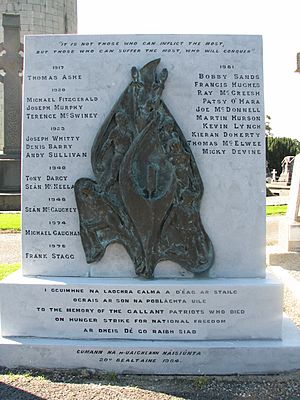Joe Murphy (Irish republican) facts for kids
Quick facts for kids
Joe Murphy
|
|
|---|---|
| Born |
Joseph Patrick Murphy
10 May 1895 |
| Died | 25 October 1920 (aged 25) Cork Gaol, County Cork, Ireland
|
| Resting place | Saint Finbarr's Cemetery, Cork, Ireland |
| Nationality | Irish American |
| Known for | Irish Republican Army prisoner who died on hunger strike |
Joseph Patrick Murphy (Irish: Seosamh Ó Murchú; born May 10, 1895 – died October 25, 1920) was an important figure in Irish history. He was an officer in the Irish Republican Army (IRA). Joe Murphy died during a hunger strike at Cork Gaol. He was one of 22 Irish Republicans who died this way in the 20th century.
Contents
Early Life and Interests
Joe Murphy was born in Lynn, Massachusetts, in the United States of America. His parents, Timothy Murphy and Nora O'Brien, were from Ireland. When Joe was a young child, his family moved back home to Cork City in Ireland.
He went to Togher National School. After school, he worked for Cork County Council. Joe loved Gaelic games, especially hurling, Gaelic football, and road bowling.
Joining the Irish Volunteers
In 1917, Joe Murphy joined the Irish Volunteers. This group later became known as the Irish Republican Army (IRA). He was a Volunteer in C Company, Second Battalion, Cork No.1 Brigade. He later became a leader (Commandant) of H Company.
Joe Murphy took part in several attacks on British police and military posts. One well-known attack was on the Farran police barracks, which was near Cork city.
Imprisonment and Hunger Strike
British forces arrested Joe Murphy on July 15, 1920. He was held in Cork County Gaol. He was accused of having a practice bomb. Joe Murphy faced a special military court called a Military Tribunal. However, he was not found guilty or given a sentence for any crime. He was simply sent back to Cork Gaol.
On August 11, 1920, Joe Murphy and many other prisoners at the gaol began a hunger strike. They did this along with Terence McSwiney, who was the Lord Mayor of Cork. A hunger strike is when someone refuses to eat to protest something.
Another Cork hunger striker, Michael Fitzgerald, died eight days before Joe Murphy, on October 17, 1920.
Death and Burial
Joe Murphy died on October 25, 1920, after 76 days without food. He was buried with full military honors in the republican plot at St. Finbarr's Cemetery in Cork. His funeral procession was led by Volunteers carrying flowers and the American Flag.
Joe Murphy is buried next to Terence MacSwiney, who also died on October 25, 1920, during the same hunger strike. He is also buried near Tomás Mac Curtain, who was the Lord Mayor of Cork before MacSwiney and was assassinated.
Nine men continued the 1920 Cork hunger strike after Joe Murphy's death. The strike was finally called off by Arthur Griffith on November 8, 1920.
Remembering Joe Murphy
In the late 1940s, Cork City Council built a new housing area in Ballyphehane. Many of the roads there were named after important people from the Irish War of Independence. One of these roads was named Joe Murphy Road, close to where he used to live.
On May 9, 2019, Joe Murphy was honored almost 99 years after his death. The Lord Mayor of Cork gave him the Service (1917-1921) Medal with Bar. This award recognized his service during the War of Independence. His family and members of the defense forces attended the ceremony at Cork's City Hall.


